Jane Dunnewold Part 3: Keep working
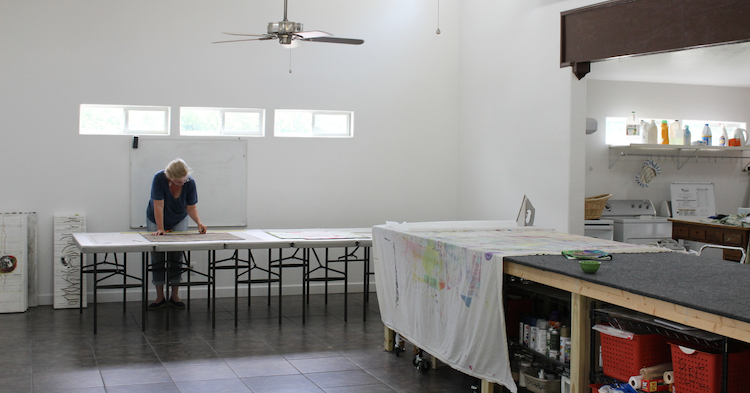
As well as creating beautiful works of art, Jane Dunnewold’s passions include the psychology of artistry and meaning. As discussed in the second part of her interview with TextileArtist.org, she is especially interested in writing and making as integral aspects of the creative process.
In this, the third and final part of our interview with this fascinating artist, she discusses what and who inspires her and offers some invaluable words of wisdom which will resonate with established practitioners just as pertinently as they do with those of you at the beginning of your careers.
“Hey, move over. Make room for me.”
What currently inspires you?
Reinventing and re-purposing – and having fun with color and imagery. I have two series going right now – one a re-working of vintage quilt pieces and patterns – riffing on their “old time” traditional names – with new interpretations – and layering vintage papers and gold leaf over the original patterns after I have applied spackling to the surfaces and sanded them down.
The second series has a working title: Inspired by the Masters and is vintage embroideries and handwork set into dye painted backgrounds inspired by still life paintings by Matisse, Chagall and others. Their exuberant use of color and playful imagery grabbed me a year ago and led me to this series, which is quite different from anything I’ve ever done, and loads of fun. I guess I finally got over feeling that I always had to do ‘serious” work in order to “earn” a place in the art textile world! Now I’m like the birds on the wire, thinking, “Hey, move over. Make room for me.”
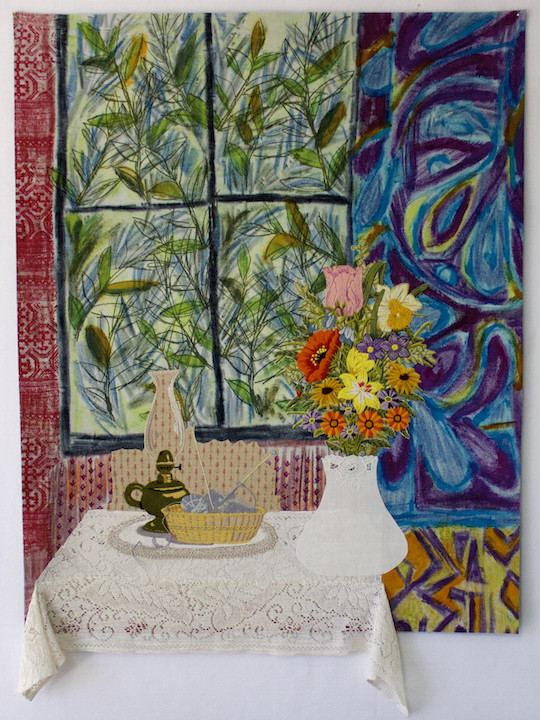
Knitting with Matisse. 2014. 38×30”. Vintage embroidery, silk noil, MX soy dye crayons, printed dye, needle felting, embroidery and machine stitching. Ecco felt backing.
Who have been your major influences and why?
Georgia O’Keefe because she was authentic, and was going to paint no matter what anyone else thought.
Barbara Lee Smith because she blazed a new path for embroiderers by writing the class Celebrating the Stitch – and encouraged me by agreeing to actually collaborate on a series, when I was still feeling inadequate and tentative about my work.
Caroline Myss, a contemporary spiritual theorist who is, I believe, brilliant in her ability to weave all spiritual traditions into a common thread that is understandable and credible. She returned me to my spiritual self.
Stephen Mitchell’s translation of the Tao te Ching – a magnificent text made even more so, by his thoughtful rendering. Those 81 brief verses changed how I understood my role on the planet in this lifetime, and made me realize what an honor and gift artists have been given. One not to be squandered by silly or petulant work.
A lesson and a gift
Tell us about a piece of your work that holds particularly fond memories and why?
When Zenna (my daughter) was seven, I got the idea to do a body print of her. But I realized I couldn’t put paint on her body without seeing how it felt and worked on mine.
So she went off to school and I stripped down, and painted my body with black textile paint. Spread out a large piece of sheeting on the floor in the TV room and knelt down. Then realized I was too big to fit on the sheeting, so did the “body” part of the print first, and then a “face” print on another piece of cloth.
Hopped in the shower and realized the downside of this experiment – when black paint went spewing onto the walls of the shower stall!
After school I proposed this body printing idea to Zenna, and she was super excited. Only being seven, her body fit perfectly, including arms stretched above her head in a victory sort of pose. And we hosed off outdoors which was the benefit of practice (and living in Texas where it’s usually very warm…)
Analysis: My image was contorted – trying to fit on the cloth. Hers was free and wildly alive.
I kept hers and still have it.
I turned mine into a quilt by stitching all the terrible words that are used to refer to women in this culture onto it: Bitch. Cunt. Whore. Dike etc
I surrounded the body print with solvent transfers of stones and actual sticks – sewn to the edges. The title? Sticks and Stones will Break my Bones, but Words will never Hurt Me. It was a making I will not forget. And a lesson. And a gift, when as an act of validation, a friend bought it.
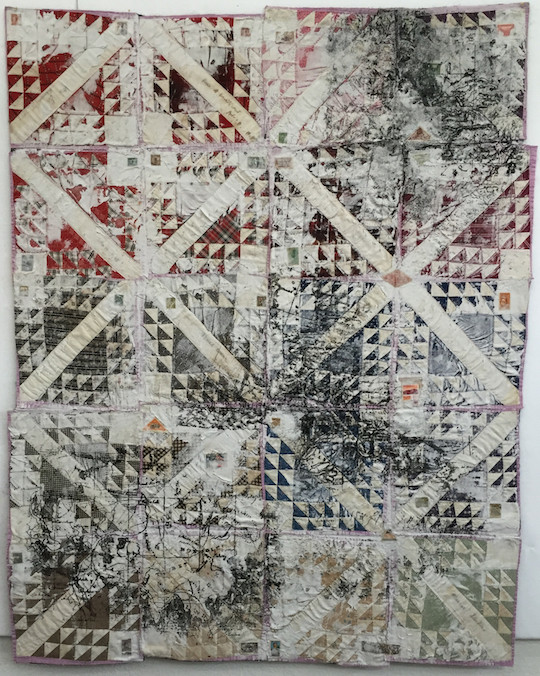
The Desolation of Goodbye. 2015. 82×45. Vintage “memory” quilt sewn and signed by several members of one family. spackling. postage stamps, printed sand in the pattern of maps from places in the world affected by migration and diaspora.
Never give up on yourself
What advice would you give to an aspiring textile artist?
- Keep working.
- Figure out who’s on your Committee – those people who shut you down or are not encouraging. Dismiss them.
- Don’t get involved with a critique group too soon. Know yourself and your work first. Make a list of what you’re good at, and what you need to learn to get better. Pursue it. Don’t default to what others think. Take time to discover what You think.
- Keep working.
- Realize maturity and an authentic “knowing” takes time to manifest. Never give up on yourself. But stay humble in case there’s something you need to do differently to succeed – whatever that means to you. Figure out what it means to you.
- Keep working.
Can you recommend 3 or 4 books for textile artists?
- Sacred Contracts by Caroline Myss
- Tao te Ching translated by Stephen Mitchell
- Finding Your Own Visual Language by Benn, Dunnewold, and Morgan
- Creativity Strength Training: Prompts, Stories and Exercises to Inspire Artistic Genius – JaneDunnewold May 2016. Pre-order now!
What other resources do you use? Blogs, websites, magazines etc.
- BrainPickings.org – Love this website
- surfacedesign.org – The Surface Design Association website
- hyperallergic.com – Great for stories on art that take us outside our usual worlds. Which is good for us!
What piece of equipment or tool could you not live without?
My fork, and wine glass.
Working together
Do you give talks or run workshops or classes? If so where can readers find information about these?
All the time. There are full listings on my own website which also describe online class opportunities and links to my blog: www.janedunnewold.com
I teach in fabulous sites like Lake Tahoe and the New York Finger Lake region, and on Whidbey Island – and will be in yurts north of Vancouver next August. And my own studio is perfect. Idyllic and organized. What could be better? Online classes are wonderful but there’s nothing like five days in a great setting with like-minded students and an embarrassment of time.
How do you go about choosing where to show your work?
I no longer work with a gallery. Decided I prefer to offer work directly to my audience. When I look for exhibition venues I look for shows with reputations, and venues that will be supportive and excited about working together.
Where can readers see your work this year?
- Visions Museum, San Diego, CA. www.visionsartmuseum.org
- my website www.janedunnewold.com
- Fibreworks Gallery: www.fibreworksgallery.com
and if I’m lucky, in a number of shows I’ve submitted work to for consideration! Will report back…..
Which words of advice from Jane particularly resonate with you? Let us know in the comments below.

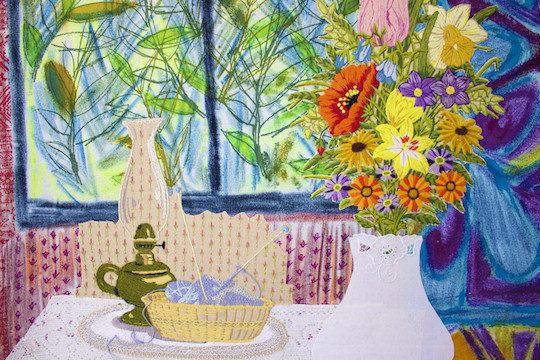
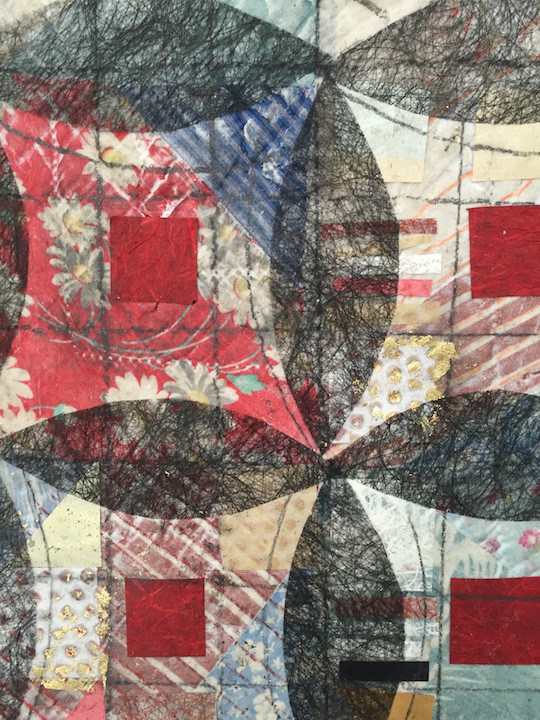
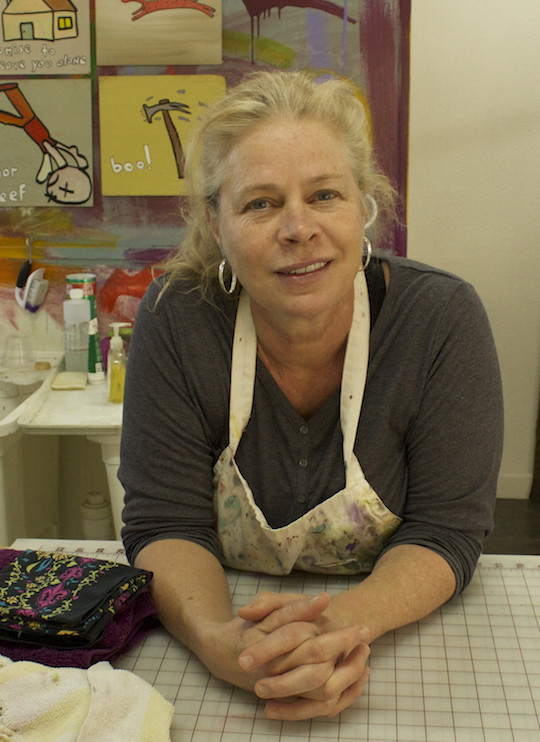















Thank you for sharing your gift. Your openness and humor are much appreciated!
Enjoying your new book
The previous section would not accept my email address. joecromer@aol.com
Buenos días
Joe y Sam
Soy artista textil y desearía que mi trabajo estuviera en su página.
Por favor dígame que puedo hacer.
Comento que tuve el agrado de conocer personalmente a su madre en Bienal Textil 2019 en Madrid
Muchos saludos
Elena
Buenos Días Elena,
Gracias por contactarte.
Envíenos un correo electrónico a hello@textileartist.org y nos comunicaremos con usted.
Todo lo mejor,
Amberley